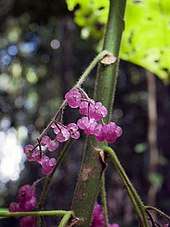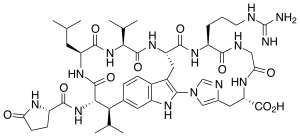Dendrocnide moroides
Dendrocnide moroides, also known as the stinging brush, mulberry-leaved stinger, gympie gympie, gympie, gympie stinger,[1] stinger, the suicide plant, or moonlighter, is a plant common to rainforest areas in the north east of Australia.[2][3][4] It is also found in Indonesia. It has stinging hairs which cover the whole plant and deliver a potent neurotoxin when touched, by the small bulb that is found on the tip of the stinging hairs being broken off and penetrating the skin to inject the toxin.[5] It is the most toxic of the Australian species of stinging trees.[2][4] The fruit is edible to humans if the stinging hairs that cover it are removed.[6]
| Dendrocnide moroides | |
|---|---|
| Scientific classification | |
| Kingdom: | Plantae |
| Clade: | Tracheophytes |
| Clade: | Angiosperms |
| Clade: | Eudicots |
| Clade: | Rosids |
| Order: | Rosales |
| Family: | Urticaceae |
| Genus: | Dendrocnide |
| Species: | D. moroides |
| Binomial name | |
| Dendrocnide moroides | |
D. moroides usually grows as a single-stemmed plant reaching 1–3 m (3–10 ft) in height. It has large, heart-shaped leaves about 12–22 cm (5–9 in) long and 11–18 cm (4–7 in) wide, with finely toothed margins.
Ecology
The species is unique in the genus Dendrocnide in having monoecious inflorescences in which the few male flowers are surrounded by female flowers.[4] The flowers are small, and once pollinated, the stalk swells to form the fruit. Fruits are juicy, mulberry-like, and are bright pink to purple, they also contain dense hair-like structures capable of injecting a toxin. Each fruit contains a single seed on the outside of the fruit.[7]
The species is an early coloniser in rainforest gaps; seeds germinate in full sunlight after soil disturbance.[8] Although relatively common in Queensland, the species is uncommon in its southernmost range, and is listed as an endangered species in New South Wales.[3][9]
The giant stinging tree and the shining-leaved stinging tree are other large trees in the nettle family occurring in Australia.
Toxicity

Contact with the leaves or twigs causes the hollow, silica-tipped hairs to break off and penetrate the skin and inject the toxins.[10] The hairs cause an extremely painful stinging sensation that could last from several hours to 1–2 days, recurring to a lessening degree for several months or more whenever the area is touched, exposed to water, or subjected to temperature change. The injured area becomes covered with small, red spots joining together to form a red, swollen welt. The hairs are also believed to be released to the air when the plant is cut or cleared in large areas. Workers without respiratory protection have reported sneezing, runny noses, mild nasal bleeding and throat irritation while cutting or clearing. Ernie Rider, who was slapped in the face and torso with the foliage in 1963, said:
For two or three days the pain was almost unbearable; I couldn’t work or sleep, then it was pretty bad pain for another fortnight or so. The stinging persisted for two years and recurred every time I had a cold shower. ... There's nothing to rival it; it's ten times worse than anything else.[11]
The sting does not stop several small marsupial species, including the red-legged pademelon, insects, including the Prasyptera mastersi[12] and birds from eating the leaves.[7]
Moroidin, a bicyclic octapeptide containing an unusual C-N linkage between tryptophan and histidine, was first isolated from the leaves and stalks of Dendrocnide moroides, and subsequently shown to be the principal compound responsible for the long duration of the stings.[13]

There has been anecdotal evidence of some plants having no sting, but still possessing the hairs, suggesting a chemical change to the toxin.[14]
Treatment
The recommended treatment for skin exposed to the hairs is to apply diluted hydrochloric acid (1:10)[15] and to remove the hairs with a hair removal strip.[16][17] If this is unavailable, a strip of adhesive tape or tweezers may be used. Broken hair tips, if they remain buried, will continue to cause pain.
See also
References
- "Dendrocnide moroides (Wedd.) Chew". Australian Plant Name Index (APNI), IBIS database. Centre for Plant Biodiversity Research, Australian Government. Retrieved 7 Nov 2013.
- Hyland, B. P. M.; Whiffin, T.; Zich, F. A.; et al. (Dec 2010). "Factsheet – Dendrocnide moroides". Australian Tropical Rainforest Plants (6.1, online version RFK 6.1 ed.). Cairns, Australia: Commonwealth Scientific and Industrial Research Organisation (CSIRO), through its Division of Plant Industry; the Centre for Australian National Biodiversity Research; the Australian Tropical Herbarium, James Cook University. Retrieved 23 July 2013.
- Harden, Gwen J. (2001). "Dendrocnide moroides (Wedd.) Chew – New South Wales Flora Online". PlantNET – The Plant Information Network System. 2.0. Sydney, Australia: The Royal Botanic Gardens and Domain Trust. Retrieved 26 Nov 2013.
- Chew, Wee-Lek (1989). "Dendrocnide moroides (Wedd.) Chew". Flora of Australia: Volume 3 (online version). Flora of Australia series. CSIRO Publishing / Australian Biological Resources Study. p. 76; figs 12, 36; map 84. ISBN 978-0-644-08499-4. Retrieved 23 July 2013.
- Hurley, Marina. "'The worst kind of pain you can imagine' – what it's like to be stung by a stinging tree". The Conversation. Retrieved 2020-03-08.
- "Is It Edible? – An introduction to Australian Bush Tucker". ACS Distance Education. Archived from the original on March 15, 2014. Retrieved 15 March 2014.
- Hurley, M. (2000). "Growth dynamics and leaf quality of the stinging trees Dendrocnide moroides and Dendrocnide cordifolia (Family Urticaceae) in Australian tropical rainforest: implications for herbivores". Australian Journal of Botany. 48 (2): 191–201. doi:10.1071/bt98006.
- If You Touch This Plant It Will Make You Vomit In Pure Agony
- "Gympie Stinger – profile". Threatened Species. New South Wales, Australia: Department of Environment and Heritage. Retrieved 26 Nov 2013.
- Hurley, Marina. "'The worst kind of pain you can imagine' – what it's like to be stung by a stinging tree". The Conversation. Retrieved 2020-03-08.
- "Once Stung, never Forgotten", Australian Geographic
- Hurley, Marina. "'The worst kind of pain you can imagine' – what it's like to be stung by a stinging tree". The Conversation. Retrieved 2020-03-08.
- "proseanet.org: Dendrocnide". Retrieved 2019-12-10.
- "Gympie-Gympie losing its sting?" Archived 2016-04-02 at the Wayback Machine, Australian Geographic
- "Gympie-Gympie Factsheet", Australian Geographic
- "Stinging Trees", Karl S. Kruszelnicki, ABS Science, abc.net.au
- "Stinging Trees - and a NEW Treatment for stings", Cape Tribulation Tropical Research Station
Further reading
- Stewart, Amy (2009). Wicked Plants: The Weed that Killed Lincoln's Mother and Other Botanical Atrocities. Etchings by Briony Morrow-Cribbs. Illustrations by Jonathon Rosen. Algonquin Books of Chapel Hill. ISBN 978-1-56512-683-1.
| Wikimedia Commons has media related to Dendrocnide moroides. |
External links
- Dendrocnide at Department of Biology, Davidson College
- Being Stung by the Gympie Gympie Tree Is One of the Worst Kinds of Pain You Can Imagine (2015-01-23), Oddity Central